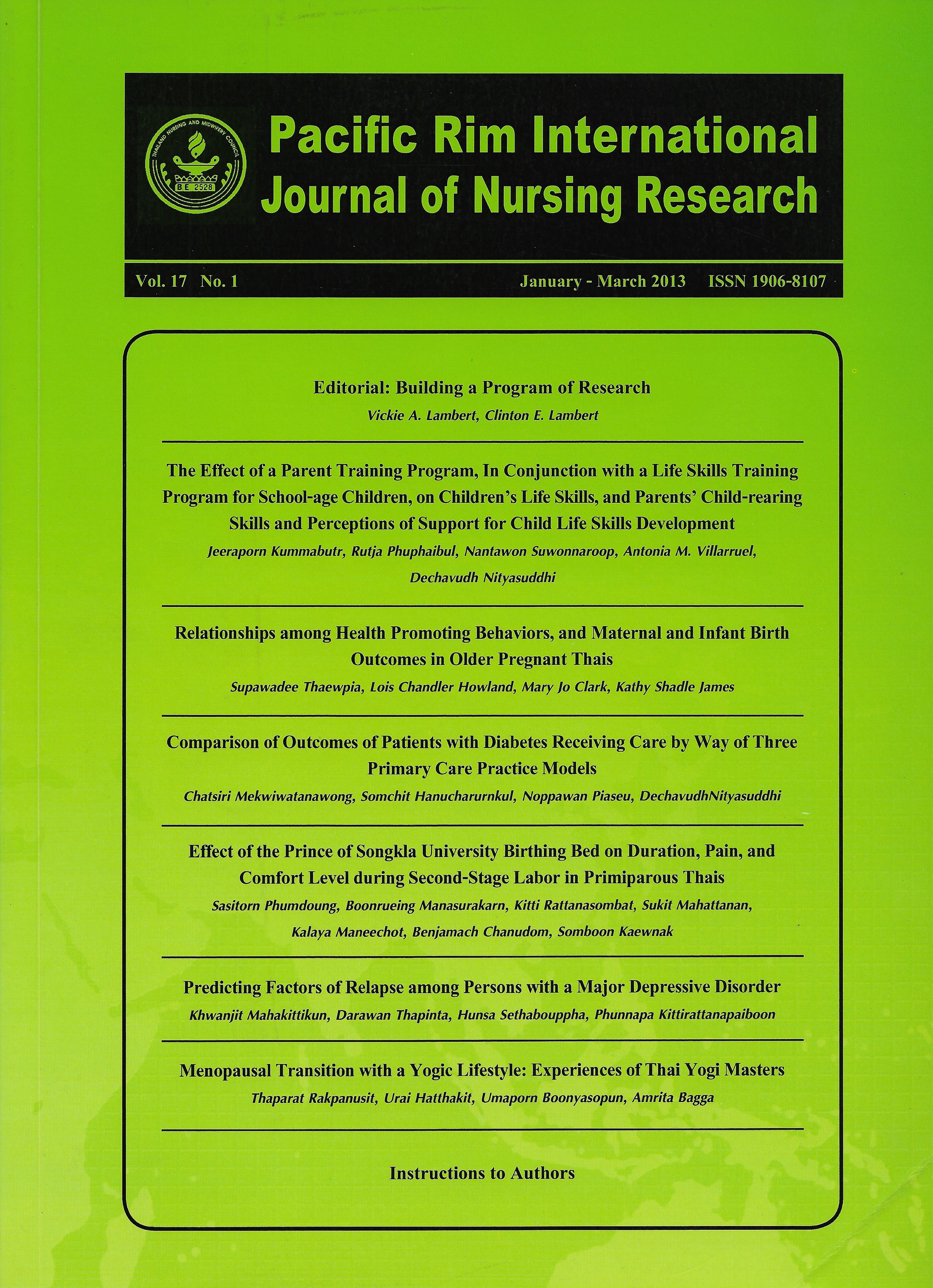Comparison of Outcomes of Patients with Diabetes Receiving Care by Way of Three Primary Care Practice Models
Keywords:
Outcomes, Patients with diabetes, Primary care practice models, Nurse practitionerAbstract
Abstract : The study’s purpose was to compare outcomes of care among patients, with type-2 diabetes, who were receiving care via three primary care practice models: a nurse practitioner-physician full-time model (NP-MDf); a nurse practitioner-physician part-time model (NP-MDp); and, an NP without a physician model (NP). Outcomes of diabetes care included glycemic control, self-care ability, satisfaction with care, and quality of life. Six primary care settings, in a province in central Thailand, were used as study sites, with each model implemented in two of the settings. A convenience sample of 300 participants, with type-2 diabetes,who were receiving care at the selected study sites, was recruited (100 for each model). Data were collected via the; Demographic Information Questionnaire (DIQ); Diabetic Self-Care Ability Questionnaire (DSCAQ); Patient’s Satisfaction with Care Questionnaire (PSCQ); and, Diabetes Quality of Life Questionnaire (DQOLQ). Descriptive statistics and MANOVA, with Tukey’s HSD, were used to analyzethe data.
Results indicated no significant difference, in the mean score of the fasting blood glucose level, was found among the subjects who received care via the three models. The mean scores of the DSCAA and DQOL of participants, receiving care via the NP-MDf and NP models, were significantly higher than those receiving care via the NP-MDp model. In addition, the mean scores of the PSA of participants, receiving care via the NP and the NP-MDp models, were significantly higher than those receiving care via the NP-MDf model.
The findings suggested that NP model can, provide care to individuals with type-2 diabetes of the same quality as NP-MDF and NP-MDP model. In addition, the results revealed the NP model was likely to achieve better psycho-social-behavioral outcomes than the NP-MDf and NP-MDp models.
บทคัดย่อ: การศึกษานี้มีวัตถุประสงค์เพื่อเปรียบเทียบผลลัพธ์ของการดูแลผู้ป่วยเบาหวานระหว่าง กลุ่มที่ได้รับการรักษาที่สถานบริการปฐมภูมิใน 3 รูปแบบ คือ รูปแบบการมีพยาบาลเวชปฏิบัติ และ แพทย์เต็มเวลา (NP-MDf), รูปแบบการมีพยาบาลเวชปฏิบัติเต็มเวลา และแพทย์บางเวลา(NP-MDp) และรูปแบบการมีพยาบาลเวชปฏิบัติเต็มเวลาโดยไม่มีแพทย์ (NP model)โดยวัดผลลัพธ์การดูแล ผู้ป่วยเบาหวานประกอบด้วยการควบคุมระดับน้ำตาลในเลือด ความสามารถในการดูแลตนเอง ความ พึงพอใจในบริการ และคุณภาพชีวิตระหว่างผู้ป่วยเบาหวาน กลุ่มตัวอย่าง คือ ผู้ป่วยเบาหวานทั้งหมด จำนวน 300 คน แบ่งเป็นรูปแบบของสถานบริการปฐมภูมิ อย่างละ 100 คน ในจังหวัดหนึ่งในภาค กลางของประเทศไทย คัดเลือกกลุ่มตัวอย่างโดยใช้การเลือกแบบสะดวก เก็บรวบรวมข้อมูลโดยใช้ แบบประเมินความสามารถในการดูแลตนเอง แบบประเมินความพึงพอใจ แบบประเมินคุณภาพชีวิต ในผู้ป่วยเบาหวาน วิเคราะห์ข้อมูลด้วยสถิติบรรยาย และMANOVA
ผลการศึกษาพบว่า 1) ระดับน้ำตาลในเลือดขณะอดอาหารของผู้ป่วยเบาหวานในทั้ง 3 รูปแบบ ไม่แตกต่างกัน (p> .05); 2) คะแนนเฉลี่ยความสามารถในการดูแลตนเอง และคุณภาพชีวิตของ ผู้ป่วยเบาหวานในรูปแบบNP-MDf และ NP สูงกว่ารูปแบบ NP-MDp อย่างมีนัยสำคัญทางสถิติ (p< .05); 3) คะแนนเฉลี่ยความพึงพอใจในรูปแบบ NP-MDp และNP สูงกว่ารูปแบบ NP-MDf อย่างมี นัยสำคัญทางสถิติ (p< .05)
ผลการศึกษาชี้ให้เห็นว่าพยาบาลเวชปฏิบัติหลักสูตรระยะสั้น 4 เดือนสามารถให้การดูแล ผู้ป่วยเบาหวานในสถานบริการระดับปฐมภูมิได้คุณภาพเทียบเท่ากับการดูแลโดยแพทย์ และรูปแบบ NP มีแนวโน้มที่จะเกิดผลลัพธ์ในเชิงจิตสังคมและพฤติกรรม (ความสามรถในการดูแลตนเอง ความพึงพอใจ และคุณภาพชีวิตของผู้ป่วย) มากกว่ารูปแบบอื่น
Downloads
How to Cite
Issue
Section
License
Copyright: The Pacific Rim International Journal of Nursing Research, Thailand Nursing & Midwifery Council has exclusive rights to publish, reproduce and distribute the manuscript and all contents therein.








.png)



